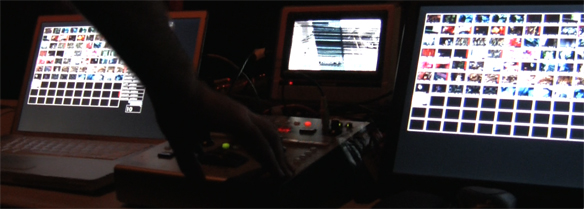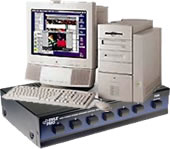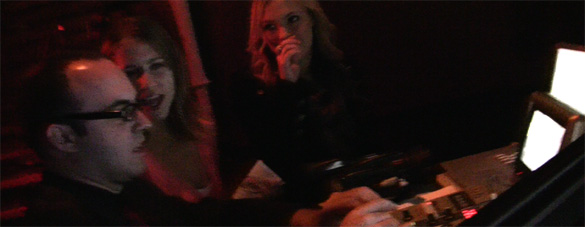Ed.: Scott Pagano is one of a handful of people you could call visualist superstars. He’s become a headline staple with some key electronica events and artists. But that’s not why I’m excited to see him here – I’m thrilled that he geeks out on some of the same stuff that makes me hot and bothered, like avant-garde contemporary architecture. Inside Scott’s DIY software rig, and inside his visual imagination, here’s CDM contributor and leading visualist himself, Momo the Monster. -PK
»Where do you find inspiration? (things/artists)
Pagano: Photography, architecture, generative systems, cinema, nature, light, music. Artists:








»What sorts of visual work do you enjoy doing?
Pagano: I enjoy working in a range of realms related to the moving image. I create short graphic films, fine art works, music videos, and live video content. I also work as a freelance designer in the broadcast and film industry. My work in music-related short film + music videos and my work in the live video space has been a symbiotic and important one to my process. Experience with live experimentation has been highly influential to the studio work and more formal finished pieces end up being a rich mine of resources for adding to the live content archive. In the live space, my most rewarding experiences have been from working with specific artists where we have developed an aesthetic relationship that allows for a true constructive interference – making the experience for the listener/viewer greater than the sum of the parts. I have curtailed my live work due to wanting to focus on those projects in addition to pure financial reality and the lack of creative satisfaction that I have experienced.
»How do you see your relationship to the VJ world?
Pagano: I figure I am a part of it but treat it as tangential to my primary focus. I see myself as an artist whose work collides with this world at times – but I’m cautious of the blinders that can be put on when one becomes -too- much a part of any one niche world.
»What software/hardware did you use at the Decibel shows?
Pagano: The setup I used at Decibel is one I have been rocking for a while now. it is -very- basic at its roots but it has worked quite well and been rock solid. The core is a max/jitter patch called “simplicityDV” that is basically a version of Grid that can play DV files straight out to a DV decoder device. when I was putting this together I was focused on being able to output the highest quality image possible and was dissatisfied with the quality of the scan converters I could afford and wanted a crisp clean image.

Two computers (one macbook pro and one mac mini) run this patch sharing media off of one hard drive that is shared between the machines over ethernet. Each machine outputs video over firewire to a sony DV>analog converter and each of those feeds a V-4. A wii controller connects to the macbook pro over bluetooth and is able to control bank/clip selection on both machines (control data sent over ethernet as OSC) as well as the crossfader and transform buttons on the V-4 (via midi). at this point I could definitely be doing what I want on one laptop – but have been hesitant to change a system that works. I am interested in looking at the new version of VDMX and the -finally- released new version of touchdesigner which is a product that I have been keeping my eye on for a long time now and want to finally devote some time to exploring.
»How is this setup different from your first VJ rig? How did it evolve?

Pagano: My first VJ rig was a Macintosh 8600, a dv camera, a vcr, and a Radio Shack speaker selector. the 8600 had a composite out and I would play files out of quicktime player. That was one big sampler! the speaker selector was my “mixer”. you get the most gorgeous glitches on every edit with that setup. Sadly lots of projectors don’t really like that signal, so optimally you would have a TBC inline – but that was way out of my league at the time.
I have used a wide range of gear and for a while was even only using dvd players with an arsenal of custom dvds that had thumbnail grid menus that I would madly scroll through. It was cheap and worked, but obviously was -much- harder to be as responsive to the music with such a rig. This was a bit of a reactionary move to having done a -lot- of work with nato + jitter and at the time getting a bit fed up with the quality and kinds of images I could generate in those environments. I spent years making a lot of glitched out insanity with those tools – but after developing a more refined studio process, I felt limited in what I could do with that software in a live setting.
I have also worked extensively with the San Francisco-based musician Christopher Willits and we have experimented with a wide range of techniques for mapping audio signal and midi data to imagery in a live context. Earlier this year we finally got to a place that I was really satisfied with. We had a fantastic gig at Monkeytown in Brooklyn where I used a three computer setup running Final Cut Pro and two different Max/Jitter patches. We synced Ableton Live to Final Cut via SMPTE Time Code to enable a base layer to be established that allowed for a general structure as well as the ability to have -very- precise transitions.
»Tell us about a favorite gig and how you prepared for it.
Pagano: Speedy J (Jochem Paap) and I headlined the Movement Festival in Detroit this year (often referred to as DEMF). I had been developing an entirely new piece of software in Max/Jitter and we finally had the time to hole up in a hotel room and get a new system working. The new software is more of an image sequencer and compositor that allows me to approach my signature masked+layered image look on a realtime system.
I had an M-Audio Trigger Finger that was connected to Jochem’s laptop running Ableton Live. we had a bank with special midi paterns set up that are only for driving the video. This way I can select a range of patterns to use as control data that are always in sync with the music.
We were also trying to tackle the issue of how to switch the video in sync with coming out of a break (mellow part sans kick drum). We implemented an audio trigger in Max/Msp/Jitter that I can enable when a break starts that listens for a low frequency impulse and then fires off midi to the V-4 to enable a hard switch when the kick drum comes back in.
We tweaked and practiced with these tools and the next day got to take them to the stage and let it all loose. The festival had brought in an amazing Barco LED display this year and it was an epic epic show.
»What are your future plans?
Pagano: My latest short graphic film was released in early november. The music is by a phenomenal duo called Trifonic from their 2008 record “Emergence”. Apple has just featured the video: Parks On Fire in the Quicktime HD Gallery, where it can be downloaded in 720p. It will be included in an upcoming issue of the Stash DVD magazine as well as the “Notations 02” DVD being released by lightrhythmvisuals.
Jochem Paap and I are headlining the saturday night event at the upcoming Spark Festival of Electronic Music and Arts on February 21st in Minneapolis. We will be performing a live version of our piece “Umfeld” as well as rocking a live audiovisual dance set afterwards. This show is a catalyst for a complete re-design of my live set and my goal is for it to be my first show incorporating Touchdesigner and more a more sophisticated sampler/compositor.
I just completed work on a library of visual content for James Zabiela that will define the aesthetics for his 2009 world tour. I created 100 minutes of intense content ranging from slow meditative landscapes to intense hyper robotic anime cg freakouts. Check his tour schedule and go see the work if you can!
I am also currently working on a large scale multi-format sci-fi project. the details are still under wraps but it has been a wonderful challenge so far to take the language of visual abstraction that i have been developing and apply it to more representational and narrative media. I have been creating a lot of concept art which is a -very- different process for me and one that i am enjoying deeply. It is always humbling to re-orient your skills and climb up a different mountain of creative + technical learning – but this process in itself is highly rewarding.
»Why do women love you so much? Is it the tie?

Pagano: What can I say, I’m italian 😉 and the tie doesn’t hurt either…